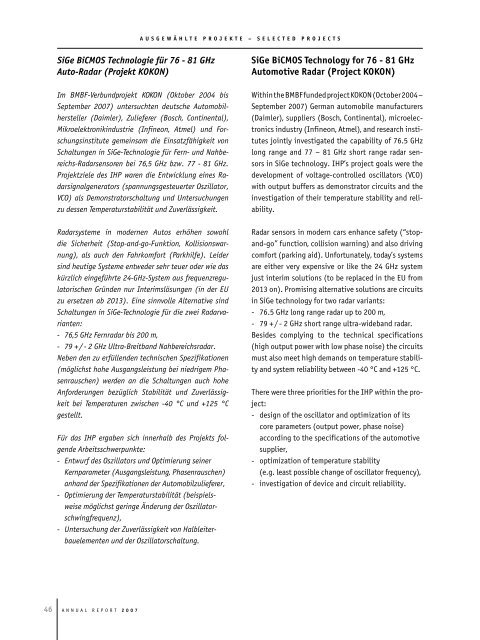Deliverables and Services - IHP Microelectronics
Deliverables and Services - IHP Microelectronics
Deliverables and Services - IHP Microelectronics
You also want an ePaper? Increase the reach of your titles
YUMPU automatically turns print PDFs into web optimized ePapers that Google loves.
SiGe BiCMOS Technologie für 76 - 81 GHz<br />
Auto-Radar (Projekt KOKON)<br />
Im BMBF-Verbundprojekt KOKON (Oktober 2004 bis<br />
September 2007) untersuchten deutsche Automobilhersteller<br />
(Daimler), Zulieferer (Bosch, Continental),<br />
Mikroelektronikindustrie (Infineon, Atmel) und Forschungsinstitute<br />
gemeinsam die Einsatzfähigkeit von<br />
Schaltungen in SiGe-Technologie für Fern- und Nahbereichs-Radarsensoren<br />
bei 76,5 GHz bzw. 77 - 81 GHz.<br />
Projektziele des <strong>IHP</strong> waren die Entwicklung eines Radarsignalgenerators<br />
(spannungsgesteuerter Oszillator,<br />
VCO) als Demonstratorschaltung und Untersuchungen<br />
zu dessen Temperaturstabilität und Zuverlässigkeit.<br />
Radarsysteme in modernen Autos erhöhen sowohl<br />
die Sicherheit (Stop-<strong>and</strong>-go-Funktion, Kollisionswarnung),<br />
als auch den Fahrkomfort (Parkhilfe). Leider<br />
sind heutige Systeme entweder sehr teuer oder wie das<br />
kürzlich eingeführte 24-GHz-System aus frequenzregulatorischen<br />
Gründen nur Interimslösungen (in der EU<br />
zu ersetzen ab 2013). Eine sinnvolle Alternative sind<br />
Schaltungen in SiGe-Technologie für die zwei Radarvarianten:<br />
- 76,5 GHz Fernradar bis 200 m,<br />
- 79 + / - 2 GHz Ultra-Breitb<strong>and</strong> Nahbereichsradar.<br />
Neben den zu erfüllenden technischen Spezifikationen<br />
(möglichst hohe Ausgangsleistung bei niedrigem Phasenrauschen)<br />
werden an die Schaltungen auch hohe<br />
Anforderungen bezüglich Stabilität und Zuverlässigkeit<br />
bei Temperaturen zwischen -40 °C und +125 °C<br />
gestellt.<br />
Für das <strong>IHP</strong> ergaben sich innerhalb des Projekts folgende<br />
Arbeitsschwerpunkte:<br />
- Entwurf des Oszillators und Optimierung seiner<br />
Kernparameter (Ausgangsleistung, Phasenrauschen)<br />
anh<strong>and</strong> der Spezifikationen der Automobilzulieferer,<br />
- Optimierung der Temperaturstabilität (beispielsweise<br />
möglichst geringe Änderung der Oszillatorschwingfrequenz),<br />
- Untersuchung der Zuverlässigkeit von Halbleiterbauelementen<br />
und der Oszillatorschaltung.<br />
6 A n n u A l R e p o R t 2 0 0 7<br />
A U S G E w ä H L T E P R O J E K T E – S E L E C T E d P R O J E C T S<br />
SiGe BiCMOS Technology for 76 - 81 GHz<br />
Automotive Radar (Project KOKON)<br />
Within the BMBF funded project KoKon (october 2004 –<br />
September 2007) German automobile manufacturers<br />
(Daimler), suppliers (Bosch, Continental), microelectronics<br />
industry (Infineon, Atmel), <strong>and</strong> research institutes<br />
jointly investigated the capability of 76.5 GHz<br />
long range <strong>and</strong> 77 – 81 GHz short range radar sensors<br />
in SiGe technology. IHp’s project goals were the<br />
development of voltage-controlled oscillators (VCo)<br />
with output buffers as demonstrator circuits <strong>and</strong> the<br />
investigation of their temperature stability <strong>and</strong> reliability.<br />
Radar sensors in modern cars enhance safety (“stop<strong>and</strong>-go”<br />
function, collision warning) <strong>and</strong> also driving<br />
comfort (parking aid). unfortunately, today’s systems<br />
are either very expensive or like the 24 GHz system<br />
just interim solutions (to be replaced in the eu from<br />
2013 on). promising alternative solutions are circuits<br />
in SiGe technology for two radar variants:<br />
- 76.5 GHz long range radar up to 200 m,<br />
- 79 + / - 2 GHz short range ultra-wideb<strong>and</strong> radar.<br />
Besides complying to the technical specifications<br />
(high output power with low phase noise) the circuits<br />
must also meet high dem<strong>and</strong>s on temperature stability<br />
<strong>and</strong> system reliability between -40 °C <strong>and</strong> +125 °C.<br />
there were three priorities for the IHp within the project:<br />
- design of the oscillator <strong>and</strong> optimization of its<br />
core parameters (output power, phase noise)<br />
according to the specifications of the automotive<br />
supplier,<br />
- optimization of temperature stability<br />
(e.g. least possible change of oscillator frequency),<br />
- investigation of device <strong>and</strong> circuit reliability.










